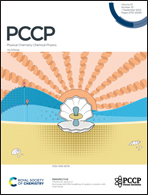A theoretical exploration of the second-order NLO properties of linked sandwich double-layered metallacarboranes: charge transfer mediated by linker groups†
Abstract
Hetero-bimetallic organic compounds have great potential for the development of new nonlinear optical (NLO) materials, due to their large first hyperpolarizabilities (βtot). Herein, due to their versatility and ease of functionalization, the second-order NLO properties of a series of linked sandwich metallacarboranes were studied by changing their linkages to different organic groups. The calculated βtot values suggest that the NLO response was significantly enhanced when an alkenyl group of appropriate length was inserted into the B–B or C–C bonds connecting the metallacarborane units. Time-dependent density-functional theory was used to explain how the connection modes and the use of organic groups as linkers can give rise to different types of charge transfer. Moreover, the NLO responses of the redox states (+1 and −1) were calculated, with the aim of investigating the NLO switching effects of the −1/0/+1 states. Comparison of the βtot values for the different states shows that the studied linked sandwich metallacarboranes could serve as three-state NLO molecular switches stimulated by redox processes.



 Please wait while we load your content...
Please wait while we load your content...